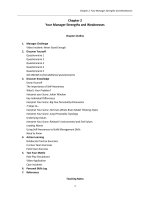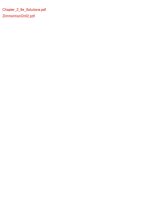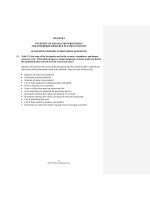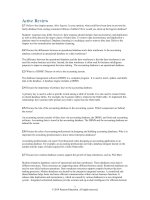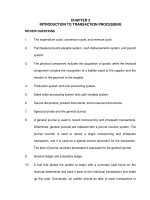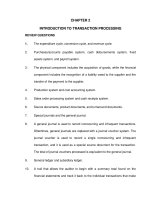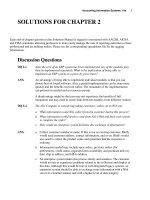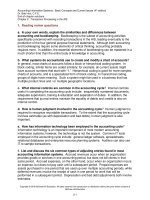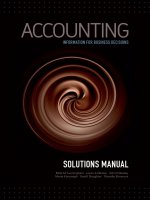Test bank and solution of algebra (1)
Bạn đang xem bản rút gọn của tài liệu. Xem và tải ngay bản đầy đủ của tài liệu tại đây (327.05 KB, 10 trang )
Chapter 2
Integers
12
3 /
2 9 9 14
44.
Exercise Set 2.1
RC2. |0| = 0; this is point C.
46. |4| = 4, and | − 7| = 7. Since 4 is to the left of 7 we have
|4| < | − 7|.
RC4. E
RC6. F lies to the right of E on the number line, so it is true
that F > E.
RC8. A lies to the left of B on the number line, so it is false
that A > B.
2. 750; −125
6. −35
10.
48. Note that | − 6| = 6, 22 = 4, |3| = 3, and 16 = 1. Then we
have
−10, −6, −5, 0, 16 , |3|, 22 , | − 6|, 7.
Exercise Set 2.2
RC2. To add −3+(−5), start at 0, move left to −3, and then
move 5 units left. The sum is −8.
4. −58.5; 56.5
8.
✥
4✥
/
3, ✥
0 0 /4
−3 4, 2 2 6
8 7 7 8
Ϫ6 Ϫ5 Ϫ4 Ϫ3 Ϫ2 Ϫ1 0
1
2
3
4
5
6
Ϫ6 Ϫ5 Ϫ4 Ϫ3 Ϫ2 Ϫ1 0
1
2
3
4
5
6
RC4. To add −8 + 3, start at 0, move left to −8, and then
move 3 units right. The sum is −5.
2. −3
4. 1
12. 3 > 0
6. 0
14. 6 > −6
8. −14
16. 0 > −9
10. −10
18. −4 < −3
12. −36
20. −3 > −4
14. 0
22. −10 > −14
16. −37
24. −3 < −2
18. 0
26. 2 > −12
20. 0
28. The distance of −6 from 0 is 6, so | − 6| = 6.
22. 1
30. The distance of 0 from 0 is 0, so |0| = 0.
24. −2
32. The distance of −4 from 0 is 4, so | − 4| = 4.
26. 11
34. The distance of 217 from 0 is 217, so |217| = 217.
28. 0
36. The distance of 47 from 0 is 47, so |47| = 47.
30. 20
38. The distance of −76 from 0 is 76, so | − 76| = 76.
32. −1
1 1
40.
34. −13
278
+829
1 107
36. 16
38. −10 + (−8) + 3 = −18 + 3 = −15
4 11
42.
6 /5 1/
−43 2
21 9
40. −1 + 20 + (−1) = 19 + (−1) = 18
42. 28 + (−44) + 17 + 31 + (−94) = 76 + (−138) = −62
Copyright
c
2015 Pearson Education, Inc.
26
Chapter 2: Integers
44. 24 + 3 + (−44) + (−8) + 63 = 90 + (−52) = 38
6. 2
46. −455 + (−123) + 1026 + (−919) + 213 + 111 + (−874) =
−2371 + 1350 = −1021
8. 0
48. 84
10. −5
12. 19
50. −36
14. 3
52. 26
16. 0
54. −52
18. −11
56. 31
20. 16
58. −18
22. −16
60. −33
24. −6
62. 17
26. −10
3 2
5 3
64.
66.
×
2
2
13 2
1 3 7,
2
5
3
6
0
0
6
1
7
4
0
1
28. −2
4
9
6
0
0
6
30. −45
32. −81
34. −52
36. 121
408
6 2451
2400
51
48
3
38. −7
40. −4
42. −8
44. −13
The answer is 408 R 3.
46. 22
68.
4 0 4 8 9,
8 0
8
8
2
6
8
8
0
7
4
3
2
1
0
1
8
3
0
3
1
5
0
5
0
5
4
1
48. 6
50. −16
52. −6
54. −21
56. 17
The answer is 221 R 331.
58. −26
70. 641,500
60. 0
72. When x is negative, the inverse of x, −x, is positive.
62. 24
74. If n = m and n is negative, then m is also negative and
−n and −m are both positive. Thus, −n + (−m), the sum
of two positive numbers, is positive.
64. 41
66. −22
68. 22
Exercise Set 2.3
70. 4
RC2. −18 − (−6) = −18 + 6; the correct choice is (b).
72. 116
RC4. 18 − (−6) = 18 + 6; the correct choice is (a).
74. 190
2. −5
76. Let D = the difference in elevations.
D = 29, 035 ft − (−1348 ft) = 30, 383 ft
4. −8
Copyright
c
2015 Pearson Education, Inc.
Chapter 2 Mid-Chapter Review
27
10. We locate the point 0 on the number line and mark it with
a dot.
78. Let A = the amount owed on the account.
A = $327 − $200 + $48 = $175
0
80. Let S = the final value of the stock.
Ϫ6Ϫ5Ϫ4Ϫ3Ϫ2Ϫ1 0 1 2 3 4 5 6
S = $61 + $5 − $7 + $3 = $62
11. Since −6 is to the left of 6, we have −6 < 6.
82. Let B = the balance after the check is written.
12. Since −5 is to the left of −3, we have −5 < −3.
B = $825 − $920 = −$95
13. Since −9 is to the right of −10, we have −9 > −10.
84. Let D = the difference in elevation.
D = −131 ft − (−512 ft) = 381 ft
14. Since 5 is to the right of 0, we have 5 > 0.
15. The distance of 15 from 0 is 15, so |15| = 15.
86. 53 = 5 · 5 · 5 = 125
88.
16. The distance of −18 from 0 is 18, so | − 18| = 18.
3 · 16 − (7 − 1) ÷ 6 − (10 − 4)
= 3 · 16 − 6 ÷ 6 − 6
17. The distance of 0 from 0 is 0, so |0| = 0.
= 48 − 1 − 6
18. The distance of −12 from 0 is 12, so | − 12| = 12.
= 47 − 6
19. The additive inverse of −5 is 5 because −5 + 5 = 0.
= 41
20. The additive inverse of 7 is −7 because 7 + (−7) = 0.
90. 27 − 23 · 3 = 27 − 8 · 3 = 27 − 24 = 3
21. The additive inverse of 0 is 0 because 0 + 0 = 0.
92. 24 · 12 oz = 288 oz
22. The additive inverse of −49 is 49 because −49 + 49 = 0.
94. False; 5 − 0 = 5, but 0 − 5 = −5.
23. If x = −19, then −x = −(−19) = 19.
96. True
24. If x = 2, then −(−x) = −(−2) = 2.
98. False; 3 − 3 = 0, but 3 = −3.
25. 7 + (−9) The absolute values are 7 and 9. The difference
is 9 − 7, or 2. The negative number has the larger absolute
value, so the answer is negative. 7 + (−9) = −2
100. True
Chapter 2 Mid-Chapter Review
1. The statement is true. See page 86 in the text.
26. −3 + 1 The absolute values are 3 and 1. The difference is
3 − 1, or 2. The negative number has the larger absolute
value, so the answer is negative. −3 + 1 = −2
2. If a > b, then a lies to the right of b on the number line.
Thus, the given statement is false.
27. 3+(−3) A positive and a negative number. The numbers
have the same absolute value. The sum is 0. 3+(−3) = 0
3. The absolute value of a number is its distance from zero
on the number line. Since distance is always nonnegative,
the absolute value of a number is always nonnegative. The
given statement is true.
4.
−x = −(−4) = 4
−(−x) = −(−(−4)) = −(4) = −4
5. 5 − 13 = 5 + (−13) = −8
28. −8 + (−9) Two negative numbers. Add the absolute
values, 8 and 9, getting 17. Make the answer negative.
−8 + (−9) = −17
29. 2 + (−12) The absolute values are 2 and 12. The difference is 12 − 2, or 10. The negative number has the larger
absolute value, so the answer is negative.
2 + (−12) = −10
30. −4 + (−3) Two negative numbers. Add the absolute
values, 4 and 3, getting 7. Make the answer negative.
−4 + (−3) = −7
6. −6 − (−7) = −6 + 7 = 1
7. The integer 450 corresponds to a $450 deposit; the integer
−79 corresponds to writing a check for $79.
8. The integer 20 corresponds to a 20◦ increase in temperature; the integer −23 corresponds to a 23◦ drop in temperature.
9. We locate the point −3 on the number line and mark it
with a dot.
31. −14 + 5 The absolute values are 14 and 5. The difference
is 14−5, or 9. The negative number has the larger absolute
value, so the answer is negative. −14 + 5 = −9
32. 19+(−21) The absolute values are 19 and 21. The difference is 21 − 19, or 2. The negative number has the larger
absolute value, so the answer is negative.
19 + (−21) = −2
33. −4 − 6 = −4 + (−6) = −10
Ϫ3
Ϫ6Ϫ5Ϫ4Ϫ3Ϫ2Ϫ1 0 1 2 3 4 5 6
34. 5 − (−11) = 5 + 11 = 16
Copyright
c
2015 Pearson Education, Inc.
28
Chapter 2: Integers
35. −1 − (−3) = −1 + 3 = 2
8. 20
36. 12 − 24 = 12 + (−24) = −12
10. 18
37. −8 − (−4) = −8 + 4 = −4
12. 110
38. −1 − 5 = −1 + (−5) = −6
14. 195
39. 12 − 14 = 12 + (−14) = −2
16. −1677
40. 6 − (−7) = 6 + 7 = 13
18. −194
41. 16 − (−9) − 20 − (−4) = 16 + 9 + (−20) + 4 = 9
20. −66
42. −4 + (−10)−(−3) − 12 = −4 + (−10) + 3 + (−12) = −23
22. 30
43. 17 − (−25) + 15 − (−18) = 17 + 25 + 15 + 18 = 75
24. 128
44. −9 + (−3) + 16 − (−10) = −9 + (−3) + 16 + 10 = 14
26. −63
45. Let T = the difference in the temperatures, in degrees
Celsius.
Higher
Lower
Difference in
is
minus
temperature
temperature
temperatures
↓
↓
↓
T
=
25
We carry out the subtraction.
↓
−
↓
(−8)
30. −48
32. −72
34. 756
36. −96
T = 25 − (−8) = 25 + 8 = 33
38. −70
The difference in the two temperature is 33◦ C.
40. 30
46. Let S = the final value of the stock.
Beginning
First
Second
Third
Final
=
+
+
+
price
change
change
change
value
↓
↓
↓
↓
↓
S =
56
+ (−3)
We carry out the addition.
28. 200
↓
+
↓
1
↓
+
↓
(−6)
42. 70
44. −5712
46. −120
48. −70
50. 120
S = 56 + (−3) + 1 + (−6) = 48
52. −5184
The final value of the stock was $48.
47. Answers will vary.
54. 48
48. The absolute value of a number is its distance from 0, and
distance is always nonnegative.
56. 5040
49. Answers may vary. If we think of the addition on the
number line, we start at a negative number and move to
the left. This always brings us to a point on the negative
portion of the number line.
58. 237,500
60. 13
62.
3 + 6[18 − (12 + 3)] = 3 + 6[18 − 15]
= 3 + 6[3]
50. Yes; consider m − (−n) where both m and n are positive.
Then m − (−n) = m + n. Now m + n, the sum of two
positive numbers, is positive.
Exercise Set 2.4
= 3 + 18
= 21
Exercise Set 2.5
RC2. To multiply two negative numbers, we multiply their
absolute values. The answer is positive.
RC4. The product of an odd number of negative numbers is
negative.
RC2. True; see page 110 in the text.
RC4. False; see page 111 in the text.
2. −6
2. −15
4. −2
4. −10
6. 9
6. −60
8. 8
Copyright
c
2015 Pearson Education, Inc.
Exercise Set 2.5
29
10. −2
54.
−7(34 ) + 18 = −7(81) + 18
= −567 + 18
= −549
56.
8[(6 − 13) − 11] = 8[−7 − 11]
= 8[−18]
= −144
58.
256 ÷ (−32) ÷ (−4) = −8 ÷ (−4)
=2
60.
(8 − 7) − 9 = 1 − 9
= −8
12. −25
14. 8
16. 30
18. 0
20. 29
22. Let l = the amount of juice left in the container at the end
of the week, in ounces.
l = 64 − 7 · 8 = 64 − 56 = 8 oz
= (−3 − 125 − 64) ÷ (36 − 100)
24. Decrease in population: 4 · 380 = 1520
= −192 ÷ (−64)
Population after 4 years: 12, 500 − 1520 = 10, 980
=3
26. Total amount of purchases: 7 · $39 = $273
New balance: $234 − $273 = −$39
28.
(−3 − 53 − 43 ) ÷ (62 − 102 )
62.
64.
8 − (2 · 3 − 9) = 8 − (6 − 9)
= 8 − (−3)
= 11
(3 − 5)2 − 4(5 − 13)
(12 − 9)2 + (11 − 14)2
=
30.
(8 − 2)(3 − 9) = 6(−6)
= −36
=
32.
10 · 20 − 15 · 24 = 200 − 360
= −160
=
34.
40 − 32 − 23 = 40 − 9 − 8
= 31 − 8
= 23
36.
4 + 10 · 20 + 8 − 23 =
=
=
=
=
3
2
=
66. 8,473,901
64 + 10 · 20 + 64 − 23
64 + 200 + 64 − 23
264 + 64 − 23
328 − 23
305
38.
4 · (6 + 8) ÷ (4 + 3) = 4 · 14 ÷ 7
= 56 ÷ 7
=8
40.
53 − 72 = 125 − 49
= 76
42.
10(−5) + 1(−1) = −50 − 1
= −51
44.
14 − 2(−6) + 7 = 14 + 12 + 7
= 26 + 7
= 33
46.
=
The digit 8 means 8 millions.
68. 23,803
The digit 8 means 8 hundreds.
12
1 9 /
2 17
70.
✥
2✥
0 /3 7
/
−1 1 8 9
8 48
1
72.
74.
−32 − 8 ÷ 4 − (−2) = −32 − 2 − (−2)
= −34 − (−2)
= −32
12
2 12
/
1 /
2, 3
/ 2
/ 7
−
4 7 6
1 1, 8 5 1
Maple trees: 13 · $23 = $299
Oak trees:
17 · $37 = $629
Total cost:
$299 + $629 = $928
76. Use a calculator.
19 − 289
19 − 172
=
132 − 34
169 − 34
−270
=
135
= −2
48. −52 + 7 = −25 + 7 = −18
50. −92 − 11 = −81 − 11 = −92
52.
(−2)2 − 4(−8)
32 + (−3)2
4 − 4(−8)
9+9
4 + 32
18
36
18
2
20 + 43 ÷ (−8) = 20 + 64 ÷ (−8)
= 20 − 8
= 12
−n
is the quotient of two
78. −n and m are negativee, so
m
negative numbers and, thus, is positive.
Copyright
c
2015 Pearson Education, Inc.
30
80.
Chapter 2: Integers
−n
−n
is positive (see Exercise 78), so −
is the opposite
m
m
of a positive number and, thus, is negative.
10. 48 ÷ (−12) = −4
Check: −4(−12) = 48
Chapter 2 Review Exercises
Chapter 2 Vocabulary Reinforcement
1. The integer 620 corresponds to earning $620; the integer
−125 corresponds to getting a speeding ticket for $125.
1. The integers are . . . , −3, −2, −1, 0, 1, 2, 3, . . ..
2. The absolute value of a number is its distance from zero
on the number line.
3. Numbers such as −3 and 3 are called opposites, or additive
inverses.
4. The difference a − b is the number c for which a = b + c.
2. The distance of −38 from 0 is 38, so | − 38| = 38.
3. The distance of 7 from 0 is 7, so |7| = 7.
4. The distance of 0 from 0 is 0, so |0| = 0.
5. The distance of −2 from 0 is 2, so |−2| = 2. Then −|−2| =
−(2) = −2.
5. The quotient a ÷ b, where b = 0, is the unique number c
for which a = b · c.
6. Since −3 is to the left of 10, we have −3 < 10.
6. The product of two negative numbers is positive.
8. Since 11 is to the right of −12, we have 11 > −12.
7. Since −1 is to the right of −6, we have −1 > −6.
9. Since −2 is to the left of −1, we have −2 < −1.
Chapter 2 Concept Reinforcement
10.
1. False; see page 93 in the text.
11.
2. True; see pages 94 and 95 in the text.
Ϫ6 Ϫ5Ϫ4Ϫ3Ϫ2Ϫ1 0 1 2 3 4 5 6
Ϫ6 Ϫ5Ϫ4Ϫ3Ϫ2Ϫ1 0 1 2 3 4 5 6
3. True; see page 107 in the text.
12. The opposite of 8 is −8 because 8 + (−8) = 0.
1
4. For a number n, −(−n) = n = . The given statement is
n
false.
13. The opposite of −14 is 14 because −14 + 14 = 0.
14. The opposite of 0 is 0 because 0 + 0 = 0.
15. The opposite of −23 is 23 because −23 + 23 = 0.
Chapter 2 Study Guide
16. If x = −34, then −x = −(−34) = 34.
1. Locate the point 4 on the number line and mark it with a
dot.
18. 4 + (−7)
4
Ϫ6Ϫ5Ϫ4Ϫ3Ϫ2Ϫ1 0 1 2 3 4 5 6
2. Since −7 is to the left of 1 on the number line, we have
−7 < 1.
3. a) The number is negative, so we make it positive.
| − 17| = 17
4. 6 + (−9) The absolute values are 6 and 9. The difference
is 9 − 6, or 3. The negative number has the larger absolute
value, so the answer is negative. 6 + (−9) = −3
5. −5 + (−3) Two negative numbers. We add the absolute
values, 5 and 3, getting 8. Make the answer negative.
−5 + (−3) = −8
6. 6 − (−8) = 6 + 8 = 14
The absolute values are 4 and 7. The difference is 7 − 4,
or 3. The negative number has the larger absolute value,
so the answer is negative. 4 + (−7) = −3
19. −8 + 1
The absolute values are 8 and 1. The difference is 8 − 1,
or 7. The negative number has the larger absolute value,
so the answer is negative. −8 + 1 = −7
b) The number is positive, so the absolute value is the
same as the number. |14| = 14
20. 6 + (−9) + (−8) + 7
a) Add the negative numbers: −9 + (−8) = −17
b) Add the positive numbers: 6 + 7 = 13
c) Add the results: −17 + 13 = −4
21. −4 + 5 + (−12) + (−4) + 10
a) Add the negative numbers: −4 + (−12) + (−4) = −20
b) Add the positive numbers: 5 + 10 = 15
c) Add the results: −20 + 15 = −5
7. −9(−8) = 72
22. −3 − (−7) = −3 + 7 = 4
8. 6(−15) = −90
9. −32 ÷ (−8) = 4
17. If x = 5, then −(−x) = −(−5) = 5.
Check: 4(−8) = −32
23. −9 − 5 = −9 + (−5) = −14
Copyright
c
2015 Pearson Education, Inc.
Chapter 2 Summary and Review: Discussion and Writing Exercises
24. −4 − 4 = −4 + (−4) = −8
31
40. Let p = the price of each tee shirt.
25. −9 · (−6) = 54
Original
minus 7 times
balance
26. −3(13) = −39
↓
68
27. 7 · (−8) = −56
28. 3 · (−7) · (−2) · (−5) = −21 · 10 = −210
29. 35 ÷ (−5) = −7
↓
−
↓
7
price of
New
each
is
balance
shirt
↓
·
↓
p
68 − 7p = −65
30. −51 ÷ 17 = −3
Check: −3 · (17) = −51
68 − 7p − 68 = −65 − 68
31. −42 ÷ (−7) = 6
Check: 6 · (−7) = −42
−7p = −133
−133
−7p
=
−7
−7
p = 19
[−12(−3) − 23 ] − (−9)(−10)
= [−12(−3) − 8] − (−9)(−10)
Each tee shirt cost $19.
= [36 − 8] − (−9)(−10)
= 28 − (−9)(−10)
33.
41.
8 − (−5) − 7 − (−9) = 8 + 5 + (−7) + 9
= 28 − 90
= 13 + (−7) + 9
= −62
= 6+9
= 15
2(−3 − 12) − 8(−7) = 2(−15) − 8(−7)
Answer C is correct.
= −30 + 56
42. −3 · 4 − 12 ÷ 4 = −12 − 3 = −12 + (−3) = −15
= 26
Answer B is correct.
34. 625 ÷ (−25) ÷ 5 = −25 ÷ 5 = −5
35.
43. a) −7 + (−6) + (−5) + (−4) + (−3) + (−2) + (−1) +
0+1+2+3+4+5+6+7+8=8
−16 ÷ 4 − 30 ÷ (−5) = −4 − (−6)
= −4 + 6
b) Since one of the factors is 0, the product is 0.
=2
44. 9 − (3 − 4) + 5 = 15
36. 9[(7 − 14) − 13] = 9[−7 − 13] = 9[−20] = −180
45.
−|8 − (−4 ÷ 2) − 3 · 5| = −|8 − (−2) − 3 · 5|
37. Let a = Chang’s total assets after he borrows $2500.
= −|8 + 2 − 3 · 5|
Initial
Amount
Total
is
minus
assets
of loan
assets
↓
a
↓
=
↓
2140
↓
−
↓
−65
We solve the equation.
Check: −7 · (−5) = 35
32.
↓
=
= −|8 + 2 − 15|
= −|10 − 15|
↓
2500
= −| − 5|
= −5
We carry out the subtraction.
46.
a = 2140 − 2500 = −360
(| − 6 − 3| + 32 − | − 3|) ÷ (−3)
= (| − 6 − 3| + 9 − | − 3|) ÷ (−3)
Chang’s total assets were −$360.
= (| − 9| + 9 − | − 3|) ÷ (−3)
38. First we multiply to find the total drop d in the price:
= (9 + 9 − 3) ÷ (−3)
d = 8(−$2) = −$16
Now we add this number to the opening price to find the
price p after 8 hr:
p = $78 + (−$16) = $62
= (18 − 3) ÷ (−3)
= 15 ÷ (−3)
= −5
After 8 hr the price of the stock was $62 per share.
39. Let t = the total gain or loss. We represent the gains as
positive numbers and the loss as a negative number. We
add the gains and the loss to find t.
t = 5 + (−12) + 15 = −7 + 15 = 8
There is a total gain of 8 yd.
Copyright
c
Chapter 2 Discussion and Writing Exercises
1. We know that the product of an even number of negative
numbers is positive, and the product of an odd number of
negative numbers is negative. Since (−7)8 is equivalent to
the product of eight negative numbers, it will be a positive number. Similarly, since (−7)11 is equivalent to the
product of eleven negative numbers, it will be a negative
number.
2015 Pearson Education, Inc.
32
Chapter 2: Integers
2. If the negative integer has the larger absolute value, the
answer is negative.
23.
−2(16) − [2(−8) − 53 ] = −2(16) − [2(−8) − 125]
= −2(16) − [−16 − 125]
3. Jake is expecting the multiplication to be performed before
the division.
= −2(16) − [−141]
4. At 4 p.m. the temperature in Circle City was 23◦ . By 11
p.m. the temperature had dropped 32◦ . What was the
temperature at 11 p.m.?
= −32 + 141
Chapter 2 Test
1. Since −4 is to the left of 0 on the number line, we have
−4 < 0.
2. Since −3 is to the right of −8 on the number line, we have
−3 > −8.
3. Since −7 is to the right of −8 on the number line, we have
−7 > −8.
4. Since −1 is to the left of 1 on the number line, we have
−1 < 1.
5. The distance of −7 from 0 is 7, so | − 7| = 7.
6. The distance of 94 from 0 is 94, so |94| = 94.
= −2(16) + 141
= 109
24. Let D = the difference in elevations.
Higher
Lower
Difference
is
minus
elevation
elevation
in elevation
↓
D
↓
=
↓
(−15)
We carry out the subtraction.
D = 2229 − (−15) = 2229 + 15 = 2244
The difference in elevations is 2244 m.
25. Let P = the number of points by which the market has
changed over the five week period.
Week 1
Week 2
Week 3
Total
=
+
+
+
change
change
change
change
↓
P
↓
=
↓
−13
↓
↓
↓
+ (−16) +
↓
↓
(−11) +
Then −| − 27| = −27.
8. The opposite of 23 is −23 because 23 + (−23) = 0.
↓
36
+
↓
19
We carry out the computation.
P = −13 + (−16) + 36 + (−11) + 19
9. The opposite of −14 is 14 because −14 + 14 = 0.
= −29 + 36 + (−11) + 19
10. If x = −8, then −x = −(−8) = 8.
= 7 + (−11) + 19
= −4 + 19
Ϫ6 Ϫ5Ϫ4Ϫ3Ϫ2Ϫ1 0 1 2 3 4 5 6
= 15
12. 31 − (−47) = 31 + 47 = 78
13.
↓
−
Week 5
Week 4
+
change
change
7. The distance of −27 from 0 is 27, so | − 27| = 27.
11.
↓
2229
The market rose 15 points.
−8 + 4 + (−7) + 3 = −4 + (−7) + 3
26. First we multiply to find the total decrease d in the population.
= −11 + 3
= −8
d = 6 · 420 = 2520
14. −13 + 15 = 2
The population decreased by 2520 over the six year period.
15. 2 − (−8) = 2 + 8 = 10
Now we subtract to find the new population p.
18, 600 − 2520 = 16, 080
16. 32 − 57 = 32 + (−57) = −25
After 6 yr the population was 16,080.
17. 18 + (−3) = 15
27. First we subtract to find the total drop in temperature t.
18. 4 · (−12) = −48
t = 17◦ C − (−17◦ C) = 17◦ C + 17◦ C = 34◦ C
Then we divide to find by how many degrees d the temperature dropped each minute in the 17 minutes from 11:08
A.M. to 11:25 A.M.
19. −8 · (−3) = 24
20. −45 ÷ 5 = −9
21. −63 ÷ (−7) = 9
22. 64 ÷ (−16) = −4
Check: −9 · 5 = −45
d = 34 ÷ 17 = 2
Check: 9 · (−7) = −63
The temperature dropped 2◦ C each minute.
Check: −4 · (−16) = 64
28. If x = 14, then −(−x) = −(−14) = 14. (The opposite of
the opposite of 14 is 14.)
Answer D is correct.
Copyright
c
2015 Pearson Education, Inc.
Chapter 2 Test
29.
33
|− 27−3(4)|−|− 36|+|− 12|
= |− 27−12|−|− 36|+|− 12|
= |− 39|−|− 36|+|− 12|
= 39 − 36 + 12
= 3 + 12
= 15
30. Let d = the difference in the depths. We represent the
depth of the Marianas Trench as −11, 033 m and the depth
of the Puerto Rico Trench are −8648 m.
Higher
Lower
Difference
is
minus
depth
depth
in depths
↓
d
↓
↓
= −8648
↓
−
↓
(−11, 033)
We carry out the subtraction.
d = −8648 − (−11, 033) = −8648 + 11, 033 = 2385
The Puerto Rico Trench is 2385 m higher than the Marianas Trench.
31. a) 6, 5, 3, 0,
,
,
Observe that 5 = 6− 1 , 3 = 5− 2 , and 0 = 3− 3 .
To find the next three numbers in the sequence we
subtract 4, 5, and 6, in order, from the preceding
number. We have
0 − 4 = −4,
−4 − 5 = −9,
−9 − 6 = −15.
b) 14, 10, 6, 2,
,
,
Observe that each number is 4 less than the one that
precedes it. Then we find the next three numbers
as follows:
2 − 4 = −2,
−2 − 4 = −6,
−6 − 4 = −10.
c) −4, −6, −9, −13,
,
,
Observe that −6 = −4 − 2 , −9 = −6 − 3 , and
−13 = −9 − 4 . To find the next three numbers in
the sequence we subtract 5, 6, and 7, in order, from
the preceding number. We have
−13 − 5 = −18,
−18 − 6 = −24,
−24 − 7 = −31.
d) 64, −32, 16, −8,
,
,
Observe that we find each number by dividing the
preceding number by −2. Then we find the next
three numbers as follows:
−8
= 4,
−2
4
= −2,
−2
−2
= 1.
−2
Copyright
c
2015 Pearson Education, Inc.
